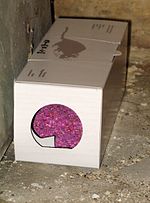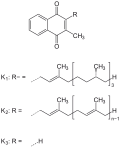Rodenticides are chemicals made and sold for the purpose of killing rodents. While commonly referred to as "rat poison", rodenticides are also used to...
29 KB (3,042 words) - 20:29, 8 October 2024
The Federal Insecticide, Fungicide, and Rodenticide Act (FIFRA) is a United States federal law that set up the basic U.S. system of pesticide regulation...
35 KB (3,658 words) - 16:41, 4 July 2024
Corn gluten meal (section Rodenticide)
flavoring. Corn gluten meal can be used as the active ingredient in rodenticides. The patent filing indicates that corn gluten meal can cause dehydration...
6 KB (676 words) - 10:30, 29 June 2024
Vitamin K antagonist (redirect from Vitamin K antagonist rodenticide)
medications in the prevention of thrombosis, and in pest control, as rodenticides. These drugs deplete the active form of the vitamin by inhibiting the...
13 KB (1,458 words) - 15:57, 21 May 2024
Bromethalin (category Rodenticides)
Bromethalin is a neurotoxic rodenticide that damages the central nervous system. Bromethalin was discovered in the early 1980s through an approach to...
7 KB (573 words) - 21:12, 15 November 2024
Brodifacoum (category Anticoagulant rodenticides)
of the world's most widely used pesticides. It is typically used as a rodenticide, but is also used to control larger pests such as possums. Brodifacoum...
24 KB (2,188 words) - 15:44, 7 September 2024
Vitamin K (section Treating rodenticide poisoning)
humans, and for animals that have consumed either the rodenticide or rats poisoned by the rodenticide, treatment is prolonged administration of large amounts...
69 KB (7,757 words) - 14:42, 24 September 2024
CropLife International (redirect from Rodenticide Resistance Action Committee)
Committee. 2020-09-14. Retrieved 2020-11-22. "Home - Rodenticide Resistance Action Committee". RRAC - Rodenticide Resistance Action Committee. 2019-09-13. Retrieved...
8 KB (598 words) - 11:48, 24 October 2024
Sodium fluoroacetate (category Rodenticides)
salt (sodium chloride) and is used as a rodenticide. The effectiveness of sodium fluoroacetate as a rodenticide was reported in 1942. The name "1080" refers...
62 KB (6,332 words) - 05:49, 10 November 2024
Pesticide resistance (redirect from Rodenticide resistance)
of anticoagulent rodenticides such as warfarin has produced almost equally widespread resistance to vitamin K antagonist rodenticides around the world...
39 KB (4,181 words) - 02:45, 7 October 2024
Difethialone (category Rodenticides)
Difethialone is an anticoagulant used as a rodenticide. It is considered a second generation agent. In May 2008, the EPA added restrictions on the sale...
3 KB (133 words) - 16:13, 7 September 2024
Cholecalciferol (category Rodenticides)
of cholecalciferol in rodenticides may still pose a significant hazard to other animals, such as dogs and cats, when rodenticide bait or other forms of...
41 KB (4,177 words) - 06:59, 25 October 2024
kill birds. Commonly used avicides include strychnine (also used as rodenticide and predacide), DRC-1339 (3-chloro-4-methylaniline hydrochloride, Starlicide)...
2 KB (202 words) - 21:18, 13 October 2024
Powdered corn cob (redirect from Powdered corn cob (rodenticide))
Powdered corn cob (PCC) is a rodenticide, marketed as a natural and environmentally-friendly alternative to anticoagulant types. The preparation was approved...
5 KB (482 words) - 17:15, 8 June 2024
Bromadiolone (category Anticoagulant rodenticides)
Bromadiolone is a potent anticoagulant rodenticide. It is a second-generation 4-hydroxycoumarin derivative and vitamin K antagonist, often called a "super-warfarin"...
6 KB (387 words) - 14:15, 25 September 2024
(EPA) announced a decision to remove second-generation anticoagulant rodenticides from store shelves, leaving the products available for purchase only...
68 KB (5,823 words) - 22:43, 2 November 2024
Aluminium phosphide (category Rodenticides)
dangerous pyrophoric compound, igniting easily in air. AlP is used as a rodenticide, insecticide, and fumigant for stored cereal grains. It is used to kill...
12 KB (1,005 words) - 07:57, 19 July 2024
classified by target organism (e.g., herbicides, insecticides, fungicides, rodenticides, and pediculicides – see table), Biopesticides according to the EPA include...
94 KB (9,519 words) - 14:11, 12 November 2024
urban areas. In bobcats using urban habitats in California, the use of rodenticides has been linked to both secondary poisoning by consuming poisoned rats...
74 KB (8,224 words) - 20:07, 13 November 2024
4-Hydroxycoumarins (category Rodenticides)
or second-generation anticoagulants in this class, were developed as rodenticides for rodents that have developed warfarin resistance. The second generation...
7 KB (633 words) - 19:30, 21 April 2024
Zinc phosphide (category Rodenticides)
although commercial samples are often dark or even black. It is used as a rodenticide. Zn3P2 is a II-V semiconductor with a direct band gap of 1.5 eV and may...
14 KB (1,251 words) - 22:38, 3 January 2024
that fishers in California were exposed to and killed by anticoagulant rodenticides associated with marijuana cultivation. In this study, 79% of fishers...
53 KB (5,940 words) - 01:30, 28 October 2024
of chemical pesticide used to kill parasitic nematodes (roundworms) Rodenticide – a category of pest control chemicals intended to kill rodents Spermicide...
1 KB (146 words) - 06:14, 23 August 2023
Warfarin (redirect from Warfarin rodenticide)
indicating its link with coumarin. Warfarin was first registered for use as a rodenticide in the US in 1948, and was immediately popular. Although warfarin was...
94 KB (9,796 words) - 09:56, 4 November 2024
Difenacoum (category Anticoagulant rodenticides)
antagonist type. It has anticoagulant effects and is used commercially as a rodenticide. It was first introduced in 1976 and first registered in the USA in 2007...
5 KB (370 words) - 15:34, 31 May 2024
Pesticide regulation in the United States (section Federal Insecticide, Fungicide, and Rodenticide Act)
regulating pesticides under the Federal Insecticide, Fungicide, and Rodenticide Act (FIFRA) and the Food Quality Protection Act (FQPA). Studies must...
76 KB (9,138 words) - 16:44, 8 August 2024
Protection Agency notes in its Proposed Risk Mitigation Decision for Nine Rodenticides that "without habitat modification to make areas less attractive to commensal...
51 KB (5,687 words) - 13:56, 31 October 2024
Substances poisonous to dogs (section Rodenticides)
licensing for use. Zinc phosphide is a common ingredient in rat poison or rodenticide. Zinc phosphide is a combination of phosphorus and zinc. If ingested...
26 KB (2,764 words) - 05:16, 22 May 2024
Hexamethylenetetramine (hexamine) Tetramethylenedisulfotetramine (TETS), a rodenticide banned in most countries Tetramine is also used as a synonym for the...
371 bytes (72 words) - 20:20, 1 November 2020
recessive genetic trait. The volatile compound has been used as inhalation rodenticide and human poison, as well as for killing whales. Cyanide ions interfere...
46 KB (4,607 words) - 23:00, 28 October 2024
























